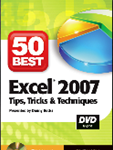The majority of the questions that I receive from viewers center on how to use and format DATES & TIMES in Excel. So, I have decided to create a series of lessons to show you how to work with dates and times in Excel. This is part one in a continuing series of free Excel Video Training Lessons.
Learn How to Work with Dates
- Use a Keyboard Shortcut to enter the current date in a cell – to “time stamp” the date.
- Use the TODAY() Function to enter a “dynamic” date function in a cell – so that your date always reflects the current date.
- Distinguish between how Excel “stores” a date – as a serial number – and how Excel formats a date – how you choose to format a date.
- Tell if a date was entered correctly – as a number – or incorrectly – as “text” by seeing how it is aligned in the cell (right or left).
- See why a fraction could be recognized as a date – and how to correct this “got’cha” step!
- How to create a series of dates in your spreadsheet.
In my experience, the majority of “Excel problems” are based around incorrect date and time entries. So, whether you are new to Excel or a veteran who gets frustrated with Time and Date calculations, this lesson is for you.
If nothing else, you will pick up some great Keyboard Shortcuts in this lesson!
Learn how to “Master Excel in Minutes – Not Months!”




















How to Annotate Excel Worksheets with Comments and Images
Do you use “post-it” sticky notes to remind you how to do something? Do you ever lose your reminder notes? I know that I do! So that is why I like to annotate my Excel Worksheets with Comments – this way I have the notes properly located (in the worksheet) when I need them (to remember how to write a particular formula, etc.) the most!
In this lesson, I also show you how to add “pictures” inside your comments. This is a great tip for adding in a picture for a catalog or order form.
A question that I am frequently asked: “How do I print out my comments?” Watch this video to find out how to do this – there are a couple of “got’cha” steps involved.
The 50 Best Tips
Here are three ways to enter a new comment that is attached to a single cell:
You can edit your comments, re size the shape of your comments, hide your comments (only a “red triangle” shows in the cell until you hover near the cell), show your comments (individually or collectively), delete, clear and paste your comments. I cover each of these techniques in this video lesson. And more!
Watch this video in High Definition, Full Screen Mode on my YouTube Channel – DannyRocksExcels
Learn how to “Master Excel in Minutes – Not Months!”